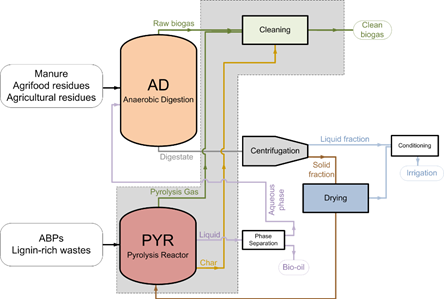-
Projects
Improving waste-to-energy processes in intensive livestock farming areas: towards a circular economy

- Start date: 01/01/2020
- End date: 31/12/2022
- Coordinator: Gloria Gea Galindo
- Type: —
- Funding: 189.000 €
Biogas generation from co-digestion of the diverse biomass wastes generated in intensive livestock areas has become an option to valorize them obtaining energy and reducing fossil fuels consumption. Livestock farming is a key sector for rural development in Spain.
However, despite the high potential for generating biogas in Spanish intensive livestock areas by anaerobic digestion (AD), the biogas production is limited mostly due to three major constraints: low flexibility for processing residues presenting limitations in their biological degradation, high costs in biogas upgrading, and lack of an adequate management way for the solid digestate. This project searches bringing new knowledge and possible solutions for overcoming these technological constraints. With a circular economy approach, the integration of AD with a pyrolysis stage would allow the recovery of those residues difficult to degrade and the solid digestate (SD), in order to obtain a char, which could be used in the digestion plant itself as a low-cost adsorbent to reduce H2S and CO2 concentrations in the biogas. Although the H2S and CO2 removal capacities of the char generated from different lignocellulosic wastes are reported in the literature, there are hardly studies on char from animal byproducts (ABPs) and SD, which are two of the most important wastes in livestock areas. Varying biomass waste composition causes the char produced to respond differently during H2S/CO2 adsorption. The effect of the composition, including the inorganic fraction, of the pyrolysed feedstock, on H2S/CO2 adsorption by the char is not yet fully understood.
The great variability of biomass wastes in livestock areas requires more understanding on how composition of feedstock, in terms of its macro-constituents interactions, influences the H2S/CO2 adsorption on char, in order to promote its use for biogas upgrading. On the other hand, nitrogen doped adsorbents are another ubiquitous choice for CO2/H2S capture due to their basic behavior. There is a lack of published information on the NH3 functionalization of char from SD or ABPs and its effect on biogas upgrading. Besides, the effect of the composition of the pyrolysed wastes on char functionalization has not been studied in depth. Once again a deep knowledge on the NH3 functionalization of the char produced from the main macro-constituents of the biomass wastes, appraising the synergistic effects, could be helpful for a better understanding of this process.
Therefore, the main objective of this project is to elucidate the role of the main macro-constituents of the typical biomass wastes in livestock facilities: cellulose, lignin, proteins and inorganics, on the H2S/CO2 removal capacity of the char produced, by assessing the synergistic effects among organic and inorganic constituents on:
- H2S/CO2 sorption mechanisms on char
- Competitive isotherms of CO2 and H2S on char
- Char regeneration
- NH3 functionalization of char as activating process
Finally, a comparative study between the char from 3 typical biomass wastes in livestock areas (olive pit as rich lignin waste, ABPs and SD) and the char from synthetic mixtures of the main macro-constituents will help to indicate where or to what extent synergy appears among feedstock constituents during H2S/CO2 adsorption on char.
The results obtained are expected to promote advances for implementation of AD as a technology economically suitable for energy generation in intensive livestock
